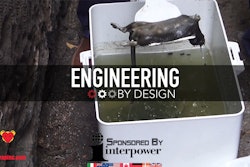Robot Ants Autonomously Work Together
Researchers from Swiss Federal Institute of Technology Lausanne (EPFL) have created tiny robots inspired by ants.
Tribots are small, 10-gram robots that work together like ants in a colony. For example, they not only communicate with one another, but assign roles to each other to complete tasks, such as jumping over obstacles or traversing uneven terrain.
Inspired by trap-jaw ants, the three legged origami robots are T-shaped. According to the researchers,the design is so simple that they can be assembled in minutes, which makes them ideal for mass production.
The Tribots operate autonomously and untethered using onboard infrared and proximity sensors. According to the researchers, trap-jaw ants escape predators by snapping their jaws together to jump from leaf to leaf. The tribots propel themselves similarly, except they use multiple shape-memory alloy actuators instead of their jaws to crawl, walk, somersault or even jump vertically and horizontally.
What is interesting is that each tribot is assigned a role: The "leader" tells the other bots what to do. For example, push a little rectangular block from point A to B. The "explorers" look for obstacles in the path, and "workers" work in tandem to get the job done. While the robots have different jobs, they can autonomously change roles if, for example, more workers are needed to move the tiny yellow block.
Like the tiny robots that we have reported on in the past, the tribots would be ideal for future search and rescue missions.
Designing minimal and scalable insect-inspired multi-locomotion millirobots was published in the journal Nature.
Researchers 3D Print Skin & Bone for Martian Transplants
Researchers are 3D printing skin and bone that could one day be used to treat patients aboard spacecraft headed to Mars -- or wherever we may go after that.
State-of-the-art bone and skin samples were bioprinted as part of a project from the European Space Agency (ESA). The samples were created by scientists at the University Hospital of Dresden Technical University (TUD).
The researchers used human blood plasma as a bio-ink to print skin cells, but the challenge is being able to 3D-print this bio-ink in space. The plasma is too liquidy, so the researchers added methylcellullose and alginate to increase the viscosity. During a space expedition, medical personnel could source these substances from plants and algae.
The team created a 3D-printed bone sample by printing human stem cells with a similar bio-ink, but used calcium phosphate bone cement to add some structure.
Next, the team is working on a list of the necessary equipment that future sick bays will need to successfully grow, harvest and implant artificial skin and bone. They are also working on developing more complex tissues that could eventually lead to 3D-printing entire internal organs for transplant.
According to the researchers, 3D bioprinting technology will help astronauts treat medical emergencies as they happen. It takes about seven months to get to Mars, so it's not like they can just turn around if someone suffers a serious burn.
Father & Son 3D Print $600K Lamborghini
Physicist Sterling Backus wanted to work on a car with his kid, but this project is a little more unique than that Celica in the garage.
For the past 18 months, Backus and his 11-year-old son have been building a 3D-printed, full-scale Lamborghini Aventador SVJ. According to Backus, he just wanted to show kids that science, technology and engineering are cool.
The project has been a financial commitment. The pair has racked up about $20,000 in expenses, but that is still much cheaper than the $639,670 price tag of the official counterpart.
The frame, suspension and drivetrain are steel (the father wants it to be safe), but other than that, the body panels, tail lights and other components have all been 3D printed in plastic and some encapsulated in carbon fiber.
According to a recent interview, the father found a 1/10th scale model online and blew it up to full size using the wheel width as a reference point. The team used Solidworks to make the 3D models printable, and while the team does have some mistakes on the scrap heap, the project is coming along well.
According to designboom, Sterling believes that they have made enough alterations to the design to stay clear of any legal troubles. For example, they made it 4” wider to make it more of a wide-body version. Sterling also uploaded the files to GrabCAD.com so anyone could piece together their own Lamborghini.
The car isn’t running yet, but the plan is to have it on the road by October and making the rounds to local schools by next spring.
This wasn’t the pair’s first rodeo, they previously worked together on a ‘69 Mustang. The father was skeptical at first, but he figured he’d give it a shot. After all, he says, “that’s how science works, we just try really crazy stuff, and sometimes it works.”
Follow the team's progress on Facebook and YouTube.
This is Engineering By Design.






















